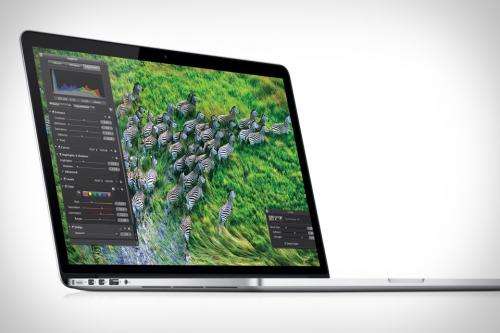Tech review: New MacBook Pro puts form over function

Steve Jobs was great at introducing devices before people realized they wanted or needed them.
Apple has also been a leader in dumping features it considers unnecessary.
Apple was the first to dump floppy disks, then analog modems, and now optical drives and Ethernet ports.
The MacBook Air came out without a built-in DVD drive or Ethernet port, and now Apple's new MacBook Pro with Retina Display joins the club.
To me, the MacBook Pro with Retina has more in common with the Air models than with the other MacBook Pros. Look at the similarities to the Air - thinner body, no optical drive, fewer ports, RAM soldered to the motherboard and no spinning hard drives, only solid-state drives.
Apple has really taken the design to another level, and I'm impressed with how it looks and performs, but I'm sad about how it's built with little regard for upgrades.
Think about the normal items to upgrade on a laptop - RAM and hard drive. Neither can be upgraded on the Retina.
Apple isn't ready to shrink the entire MacBook Pro line just yet, as it has also introduced new models of the more traditional 13- and 15-inch MacBook Pros that do still have upgradeable RAM and hard drives and optical drives. The 17-inch MacBook Pro is gone.
The first word I thought of when I unboxed the new MacBook Pro was "sexy." It's a quarter-inch thinner and more than a pound lighter than the non-Retina 15-inch model. Heck, it's only 0.03 inches thicker than a MacBook Air.
The Retina display is the selling point here, and the 2880-by-1800-pixel screen has more than 5 million pixels, which is enough to edit full-screen 1080p high-definition video in Final Cut Pro and still have more than 3 million pixels left over for your work palettes.
It's easily the most beautiful screen I've seen on a laptop.
Apple has optimized its own programs, such as Mail, iPhoto, Aperture, Final Cut Pro, iTunes and Safari, to look great on the Retina display. I expect other software developers to quickly follow suit.
The Retina laptop's storage is solid-state only, with speeds up to 500 MB per second. The lower-end model (2.3 GHz quad-core i7) is limited to 256 gigabytes; the faster model (2.6 or 2.7 GHz quad-core i7) is configurable with a 512 GB or 768 GB drive.
The 2.3-GHz model with 8 GB of RAM and a 256 GB solid-state drive will run you $2,199. On the other end of the scale, the 2.7-GHz model with 16 GB of RAM and a 768 GB drive will set you back $3,749.
Be careful when you make your build-to-order choices, as it's your only chance to buy RAM or storage space.
Apple is getting a bit more affordable in its options. The upgrade from 8 to 16 GB of RAM is only $200.
Bumping that solid-state drive from 512 GB to 768 GB costs an extra $500.
All models ship with NVDIA GeForce GT 650M and Intel HD Graphics 4000 video boards with automatic video switching.
Two external displays are supported at resolutions up to 2560 by 1600 pixels each. Those screens can be run through the two Thunderbolt ports or the built-in HDMI port.
The FaceTime camera is HD with 1280-by-720-pixel resolution.
The USB ports have been upgraded to USB 3.0, but they work with older devices also.
Apple also separated the USB 3.0 ports so there is one on each side. This is a small change, but it means a lot to power users like me who find that some USB peripherals are a bit too wide and block the adjacent ports.
The Retina MacBook Pro is the first Apple portable to feature two Thunderbolt ports.
Rounding out the ports is an SDXC memory card slot.
The battery is a 95-watt-hour Lithium-polymer model that provides up to seven hours on a charge.
The new stereo speakers really do sound great for a laptop. They sound better than most clock radios and at least as good as iPod speaker docks.
There are dual microphones for better audio input, and Mac OS 10.7.4 (Lion) is pre-installed.
I'm not sure where Apple is trying to position the Retina model. Its $2,199 starting price is quite reasonable.
I configured the new MacBook Pro with optical drive with the same 2.3 GHz i7 with 8 GB of RAM and a 256 GB solid-state drive and the optional widescreen display, and the total hit $2,499. So the Retina MacBook Pro is $300 less than the model with a lower-resolution screen and included optical drive.
I suppose, to make it fair, I should add the $99 external super drive, making it $200 cheaper with pretty much the same hardware.
To be even fairer, I could add $29 each for Ethernet and FireWire 800 dongles because the Retina model lacks those ports, which the traditional MacBook Pro includes. Which to choose? If you think you might want to upgrade your RAM/hard drive in the future, I'd go with the traditional model. Otherwise, the Retina version is hard to pass up.
I ran the benchmarking program Geekbench on the Retina model against last year's 15-inch Macbook Pro with a 256 GB solid-state drive. The Retina model scored 11,050 and the year-old MacBook Pro scored 10,025.
Overall, I love the new Retina MacBook Pro, and it would be my choice if it were time to get a new laptop.
---
APPLE MACBOOK PRO:
-Pros: Thinner, lighter, faster.
-Cons: No optical drive, fewer ports, dongles required for some ports.
-Bottom line: Sexy beats functional every day of the week. (Well, maybe six out of seven days.)
-Price: Starts at $2,199
-On the Web: store.apple.com/mac/
(c)2012 The Dallas Morning News
Distributed by MCT Information Services




















